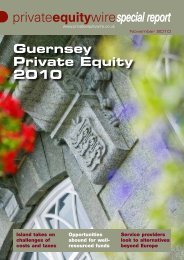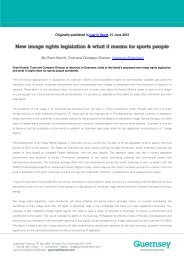Link - Guernsey
Link - Guernsey
Link - Guernsey
- No tags were found...
Create successful ePaper yourself
Turn your PDF publications into a flip-book with our unique Google optimized e-Paper software.
GUERNSEY 2010CRAgreements asan alternativePierre Paul of RLAM offers Security InterestAgreements as an alternative to Letters ofCredit for captivesRoyal London Asset Management(RLAM) has managedcash investment portfoliosfor a number of <strong>Guernsey</strong>captive insurance companies. RLAMwas incorporated in 1987 since whenwe have concentrated purely on cashmanagement, aiming to become aniche player in this field and provide afirst-class service at a competitive price.However, despite our focus on cashmanagement, we are flexible enoughto assist clients in creating solutions toproblems.A notable success has been ourinvolvement in a number of SecurityInterest Agreements (SIAs), enablingthe clients involved to dispense withcostly Letters of Credit (LoCs).RLAM entered into its first SIA on 6December 1994 following an approachfrom a client, the captive of a largetextiles manufacturer, who had beenrequested by its reinsurer, GuardianRoyal Exchange (GRE), to provide securityin respect of insurance liabilities.In these circumstances, the mostcommon form of security a captivecould offer was a LoC issued by a bankin favour of the insurer. Our client didnot want to go down the LoC route onthe grounds of cost, the first cost beingthe fee charged by the bank issuing the“Where an SIA is acceptable,it can certainly help a captivereduce its costs”LoC. Second, because our client wouldbe required by the bank to place fundson deposit as collateral for the LoC,the client would lose valuable investmentincome. Both of these costs droveour client to seek an alternative formof security to offer GRE.Luckily for our client, <strong>Guernsey</strong>’sRoyal Court had recently enacted theSecurity Interests (<strong>Guernsey</strong>) Law, 1993which meant that it was now possible totake a charge over financial or other intangibleassets. Another stroke of goodfortune was that one of the lawyers whohad drafted the legislation was also anon-executive director on the board ofour client company.Accordingly, an agreement wasdrawn up between the captive and theinsurer in which the captive, referredto as the ‘debtor’, pledged assets of agiven value to the order of the insurer,referred to as the ‘creditor’. Under theagreement, the assets remain ownedby the debtor leaving them free toenjoy the benefits of those assets suchas interest or dividends. However,contingent on a range of scenarios,ownership of those assets would transferto the creditor in order to dischargeproven insurance liabilities that hadarisen out of claims under the insurancecontract.A key feature of this agreement wasthe insertion of a third-party custodianbetween the debtor and creditor whosejob was to hold the assets securely ina way which facilitated the continuedactive management of those assets bythe investment manager, in this caseRLAM.Once the document had been approvedby all three parties it was executedand given the none too catchyname of a Security Interest Agreement(SIA). Included in the SIA were variousclauses which allowed the amount ofassets held as security to be increased14 Captive review www.captivereview.com











